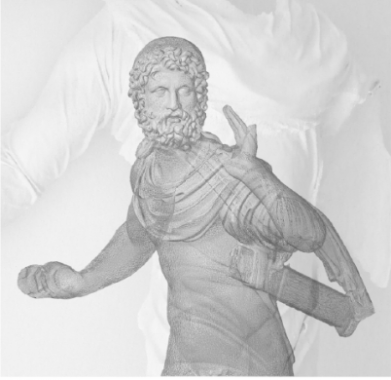Hellenic and contemporary sculpture are in direct comparison designing new paths to learn, co-create and share, online and offline, beauty. This is, in few lines, the essence of Ulisse II (Ulysses II), an art project arisen from the collaboration of Erminio Paolo Canevese (Virtualgeo) and Michela Sediari, senior officer of Archaeological State Museum of Venice located in Piazza San Marco (Saint Mark square), Venice, Italy - curated by Alfredo Cramerotti. Virtualgeo already designed advanced software and 3D visualization for the same museum, and for others in Italy and abroad, by applying Geomatics, stereoscopic, augmented reality and 3D scanning languages to popularise and valorise collections, restorations, new museum exhibition settings and the most innovative media art, as in a recent exhibition within the 54th Venice Art Biennale.
The Japanese artist Makoto – who has been invited by Canevese and Cramerotti to dialogue with one of the most outstanding representations of Ulysses - reacted by carving a oversize, light, suspended, figure made of contemporary materials, from gesso to Japanese paper.
Ulysses (marble, cm 105, dating 138-192 AC, belonging to Grimani Art Collection, 1523) is carved by picking the instant in which the hero steps in a dynamic outburst: at its right there is a pedestal made in form of a log on which he sets down the armour. The statue is a Roman ouvre dating II Century AC and we know the name of the Renaissance restorer, Tiziano Aspetto, one of the most trusted by Grimani family among the finest carvers of his time. Ulysses, the intrepid and astute king of Ithaca sung by Homer, comes back in the native land after never ending wanderings on the seas: it is either the protagonist of the nostos (journey) par excellence and the symbol of Greeks’ maritime calling people, whose nautical competences were crucial by inhabiting a land entirely windowing the sea. As it is Venice – and as Japan is.
The Grimani’s Ulysses statue has been reproduced in digital by Virtualgeo via a 3D scanning with structured light acquisition techniques, further modelled in 3D.
The 3D model is the accurate copy, in form and colour, of the statue and is an informative output: the various restorations the work of art was subjected to in the past centuries have been marked thanks to the three-dimensionality and the peculiar 3D modelling techniques used for. The visitors of the Archaeological State Museum are enabled to explore the Ulysses also in the fourth dimension (the time) and thanks to ECH (Edutainment for Cultural Heritage) – a digital platform for scientific popularization designed by Virtualgeo and accessible via a touch-screen totem placed beside the statue, endowed to the Museum – can study the history of the restorations, create posters and personalized books to share online (with the statue, that can be digitally explored by touching the screen, combined with one of hundreds of backdrops of Saint Mark Square and the available museum halls, or with an instant selfie).

